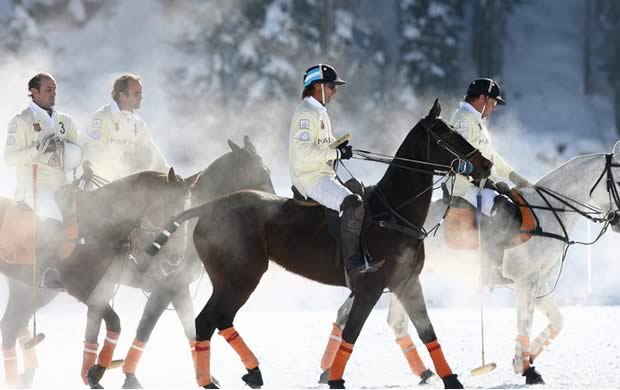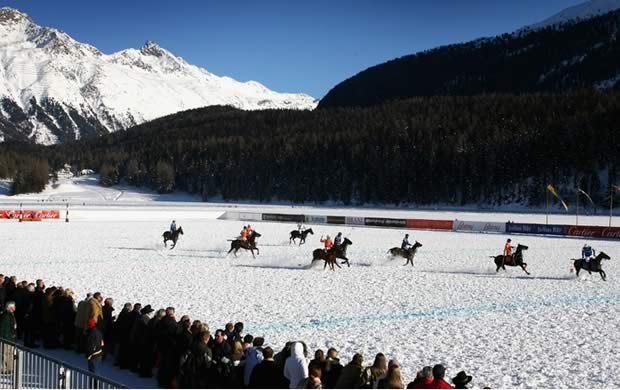
Horseytalk.net Special Interview
Reto Gaudenzi
The champagne is on ice. It's time for snow polo

Beneath the snow-capped peaks of St Moritz a group of hardy souls are ditching their skis, and jumping on a horse.
Below the pistes, it's time for snow polo.
Winter in the Swiss resort sees a group of dedicated players transform a frozen lake into a battlefield of hooves and mallets.
"We couldn't wait until summer came again, so we had to be creative," explains Reto Gaudenzi, who organizes the tournament.
And if sending a bunch of horses onto a frozen lake sounds like a recipe for disaster, Gaundezi points out: "Horses on snow are not new."
St Moritz has been doing this for a while. Its annual snow polo event began in 1985 and, since 1907, a series of horse races dubbed the "White Turf" have been staged each February, involving not just hockeys but "skijorers" who ride behind their horse, on skis.
"The question is how to play sport on the lake, with the abrupt motion that polo has," continues Gaudenzi.
"The technical possibilities have changed dramatically. Thirty years ago we had a little Bombardier machine to try to make a field. Now we have sophisticated machinery to make the surface. Better surface, better polo -- that is the secret of polo.
"We create the field by mixing the ice with layers of prepared snow, so it doesn't get slippery. Then, we invented a shoe for the horse so the snow doesn't pile up in the hoof."
That is achieved thanks to a rubber pad between the shoe and the hoof, which dislodges snow. Modern snow polo horseshoes also use a lip at the toe, coupled with cleats at the heel, to give horses the traction to compete safely.
In another safety move, the game's periods -- or chukkas -- are shorter. Playing polo in the rarefied St Moritz air is more tiring for horses (and humans) than life at sea level.
"Snow polo is very different," says Rommy Gianni, captain one of the teams at this year's event, in late January and early February.

"The game is a bit slower -- there is less control of the ball since you're playing on snow, it's very difficult to have control -- but it's faster mentally.
"The game can change from one second to another in a faster way compared to playing on grass. It's slower, but somehow more difficult to play."
The high-visibility orange ball helps to slow the game, and also makes it trickier, being softer and larger than a standard polo ball.
"Some of the best players in the world get along with it -- some don't," says Gaudenzi.
"You have to have a different swing. If you hit it at full strength, it has a worse effect. Like soccer, you have to have the feeling for the ball, it's more sophisticated.
"It's funny to see some very good players who don't get along with it. In 30 years, we've found out who is good and who is not so good... and we invite the good guys."
That is a matter of opinion.
Somewhat bizarrely, for a sport quite this exclusive, rival snow polo events face off each February -- both calling themselves the World Cup.
St Moritz bills itself a World Cup and proudly maintains it is the original, and best. But, over in Tianjin, China, organizers are preparing to host a Snow Polo World Cup of their own.
The Chinese one is backed by the Federation of International Polo (FIP), the sport's world governing body.
"We feel it is really the ultimate world championship," says Dr Richard T Caleel, who stood down as FIP president in late 2014.
"All of the teams [in Tianjin] are national teams, they do actually represent their countries, the players all have to be citizens of that country. That's a twist to most of the other tournaments, where teams are frequently mixed."
Dr Caleel is correct that in St Moritz, teams are usually a mix of nationalities backed by a major sponsor.
For instance, Gianni's team will feature the Italian alongside a German and two Argentinian pros.
Gianni, making his St Moritz debut after 10 years playing snow polo, is convinced he is heading to the toughest tournament in the world.
"The most competitive event on snow, from what I've heard and seen, is St Moritz," he insists.
And organizer Gaudenzi, naturally, won't hear of any competition for snow polo's crown.
"It's a jungle out there," he admits, with a laugh. "Everybody does more or less what they want. But they call St Moritz the Wimbledon of snow polo in the newspapers here. It's the best tournament in the world.
"Optically, it's unbelievable. You're at 1,800 meters (5,905 feet) on a frozen lake, playing polo in the snow with a blue sky. It's a very unique thing.
"And the food is fantastic. We have world-class chefs, the champagne is flowing, the vodka -- no caviar, the lake is frozen so we can't get the fish out," he jokes.
"If you bring caviar, you'll make some friends."
You'll be paying upwards of $500 to get at the chefs and champagne, who are there to serve the many VIPs who descend on St Moritz each year.
But, as Gaudenzi points out, admission to the lakeside grandstand is free.
"You go there, you buy your sausage, you drink your beer, you watch snow polo," he instructs.
"You have the snow, the cold, the blue sky, the mountains -- the horses, you see the steam -- it's high-class polo. It's the best tournament in the world."









